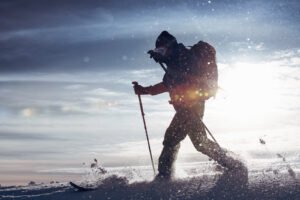WINTER TOURIST ATTRACTION – SKI TOURING IN DURMITOR 2021








Touring skiing has been increasingly popular among nature and sports lovers in recent years and is becoming one of the favorite forms of movement during the winter. In terms of mass, it can be compared to cross-country skiing, despite the fact that due to the conditions dictated by nature, this activity is more towards the mountains. Lay people equate ski touring with off-piste skiing. We call this type of skiing simple skiing, or better, skiing off the groomed trails, which is why we use the term "freeride skiing" due to our lack of familiarity with local terminology.
Touring skiing is fundamentally different in the way of performing the ascent itself, because we base the entire tour on our own abilities. When touring, we use special ski touring equipment that allows us to climb easily and efficiently with skis on our feet. During the tour, we can connect one or more peaks, depending on fitness and current snow conditions. From the top, we then ski down into the valley. Touring skiing is a real experience that includes both climbing and descending, thus combining mountaineering and skiing in a natural environment.
Special ski touring equipment is used for ski touring. A very important part of the equipment are tour bindings that allow walking with skis on the feet, and special "skins" that we stick on the sliding surfaces of the skis during the ascent, which allows us to walk uphill, without sliding backwards. Before starting the descent, we peel off the "skins" and pack them, and then we can ski normally.
Touring skis themselves differ from skis for alpine skiing mainly by their lower weight. All ski touring equipment is much lighter, first of all for practical reasons, because it needs to be carried under its own power to the chosen destination. Ski touring footwear is specialized so that it allows walking and skiing and represents a compromise between rigid and hard armor for alpine skiing and soft mountaineering boots. Ski touring also requires poles with larger snowshoes, which makes it much easier to move in deep snow.
The rucksack is the basic part of the equipment, in which there must be first aid equipment, spare clothes, food and drinks. Ski touring in the mountains is usually done in winter and early spring. Due to the special movement in the mountainous environment with snow, we must not forget the basic "safety trio", which contains a transceiver, a shovel and a probe. The avalanche transceiver emits signals and, in case of rescuing snow-covered skiers after an avalanche, enables their location to be determined. An avalanche probe is used to determine the exact location and position of a buried body, and we need a snow shovel for faster digging.
The technique of walking on touring skis is very similar to walking on Nordic skis. If you have tried it, it will be much easier and clearer for you. When walking, the skis are hip-width apart, which gives us the best stability on the skis. Tightly placed skis will throw us off balance. During walking, we transfer the weight of the body (to a significant extent) to the landing leg by loading it with the entire surface of the foot. We do not lift our skis while walking, but drag them across the snow. Lifting skis while walking is the biggest mistake beginners make. Imagine how much extra weight it is when you needlessly lift your skis and body armor at every step. Thousands of steps accumulate a lot of unnecessary weight. You really don't need that kind of fitness, do you? The rhythm of walking should be even, regardless of the slope, because your goal is not to achieve interval training. On flat terrains, we lengthen the stride, and on steep slopes we shorten it. When walking, we use poles in the same way as in Nordic skiing in the rhythm of the left foot and the right hand and vice versa. On the flat parts, we use the sticks for balance, while on the slopes, the sticks are used to push us away. On larger slopes, stick the upper stick a little lower so that you don't hold your hand too high.
We choose the terrain for walking by looking at the external conditions, the relief of the terrain as well as the slope. A mistake made by beginners is choosing a terrain that is too steep. The ideal slope of the terrain is about 20 degrees. This provides us with pleasant touring without excessively lifting the heel, our skins receive us nicely, we climb gradually, which saves us a lot of energy. In deep snow where the board has not yet been made, the skis dig deep into the snow and it becomes very tiring. In such conditions, we raise the tips of the unloaded ski so that they are on the surface, then push the ski forward and then load it again. When walking on hard snow, it is very important to place the skis on the entire surface. When we don't feel the necessary support under our feet, especially when crossing a slope, we unconsciously place our skis on the curbs. The risk of slipping in that position is greater. In hard snow we have three options:
1. we easily cross the steep slope in a gentle descent, until we reach a gentler terrain.
2. place the bottom ski in the plow (in the plow) and thus load as much of the ski's sliding surface as possible.
3. we install light boots, a type of crampon for skis and adjust the walking technique.
Touring skiing develops exceptional fitness and mental stability in humans. Touring involves navigating and finding your way through snowy wilderness. For those who have the knowledge to safely visit the wilderness, the experience is indescribable. Turno skiers can reach mountain areas completely deserted in winter and feel real peace and quiet. Tourno skiers can also experience a sense of independence that is so rare in the modern world.
Touring skiing is very popular with people who are looking for a pristine prsic for skiing because there is no such thing in organized ski resorts. In the spring, it makes it possible to reach places in the high mountains where there is still snow for skiing, even though it has long since melted in easily accessible places. On touring skis, a person is independent and can go to the mountains and ski on wild, untouched snow.
Touring skiing it can be faster and easier than summer hiking in the mountains and therefore allows traveling on the mountain and reaching places that are otherwise inaccessible. In this way, skis provide access to places that are interesting for alpine climbing in winter and would otherwise be inaccessible due to the long and tiring way through the snow on foot. On the other hand, in spring or even summer they provide access to some distant rocks that are clear of snow for climbing and are located above a glacier.
